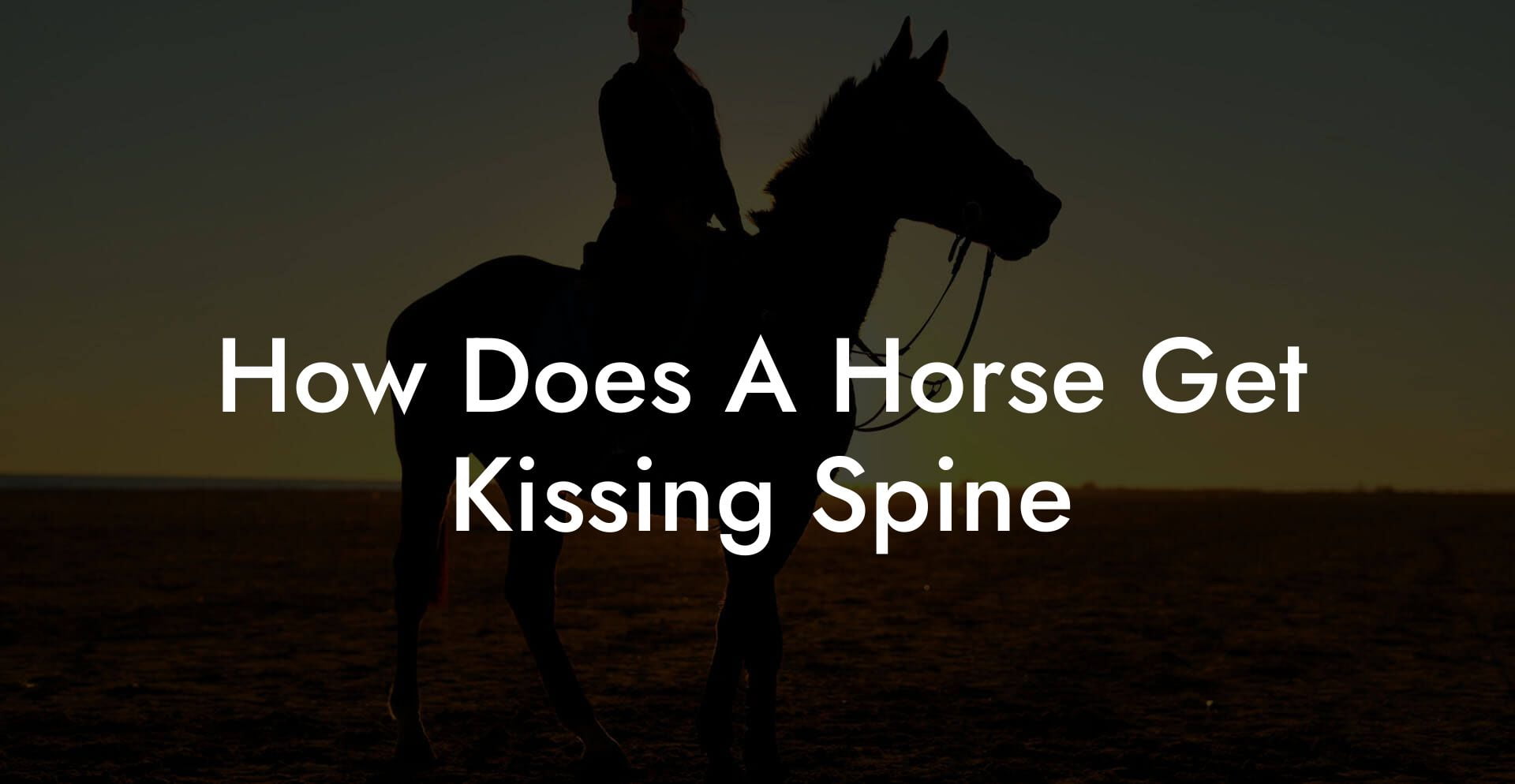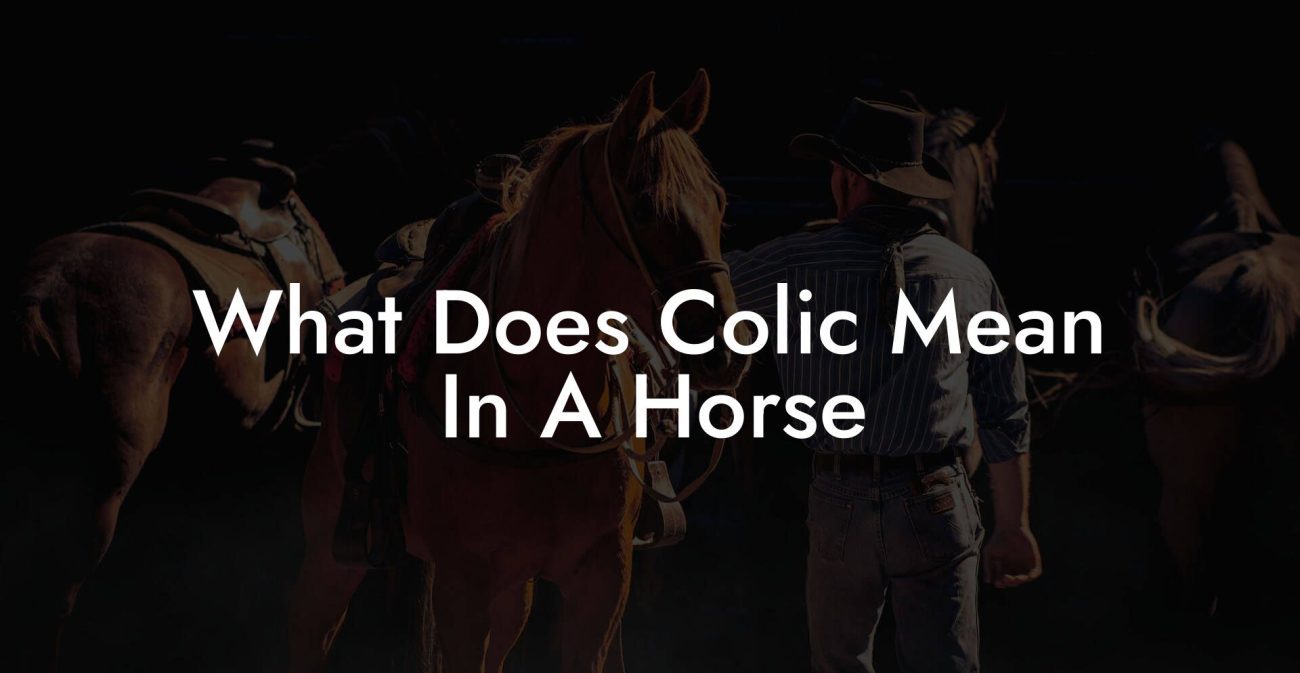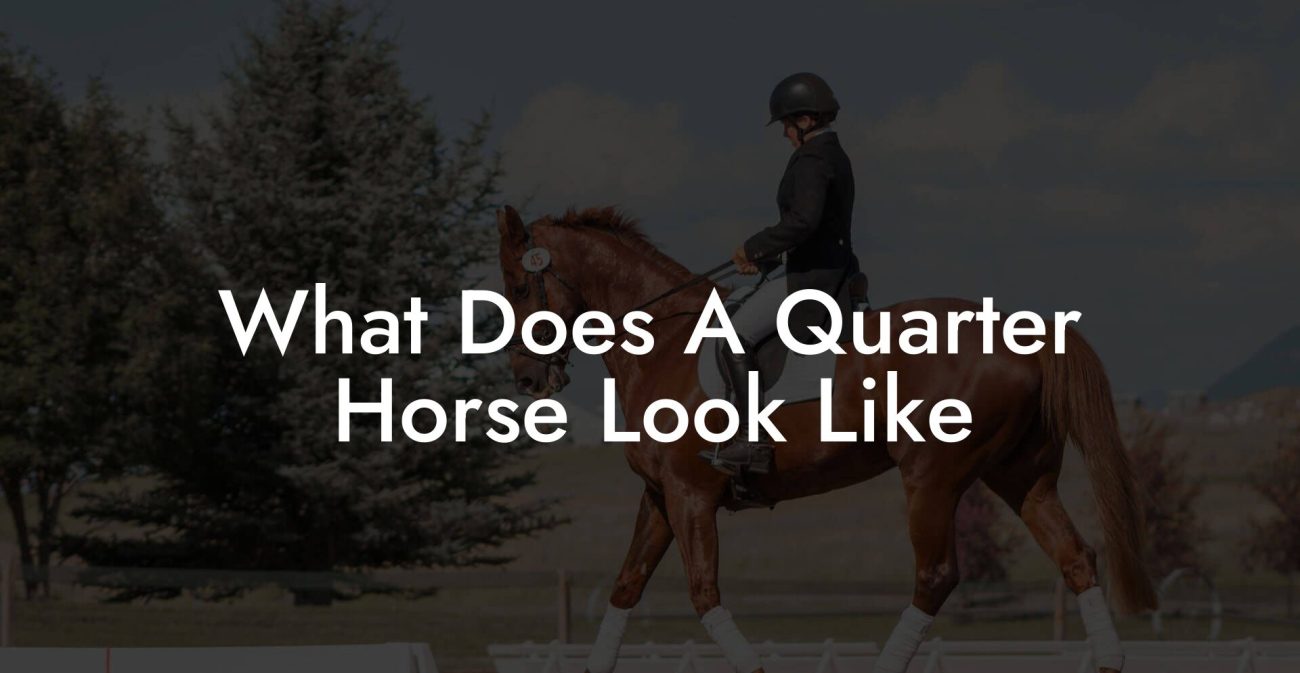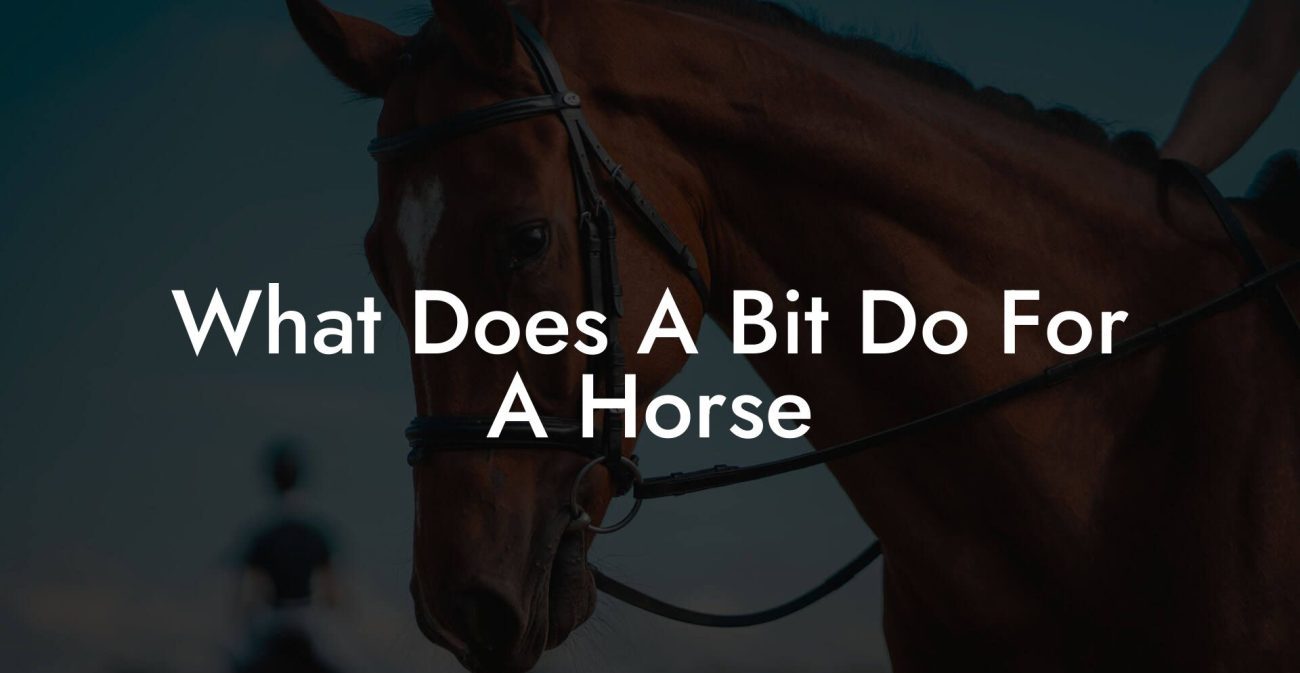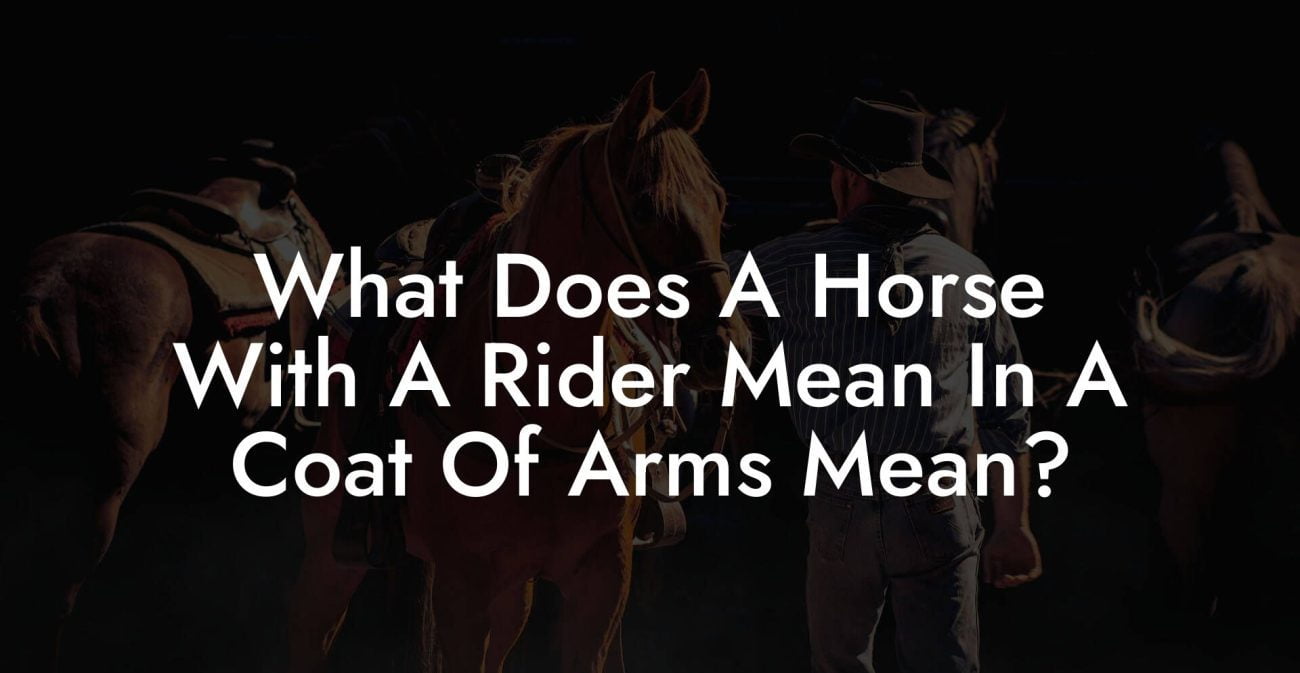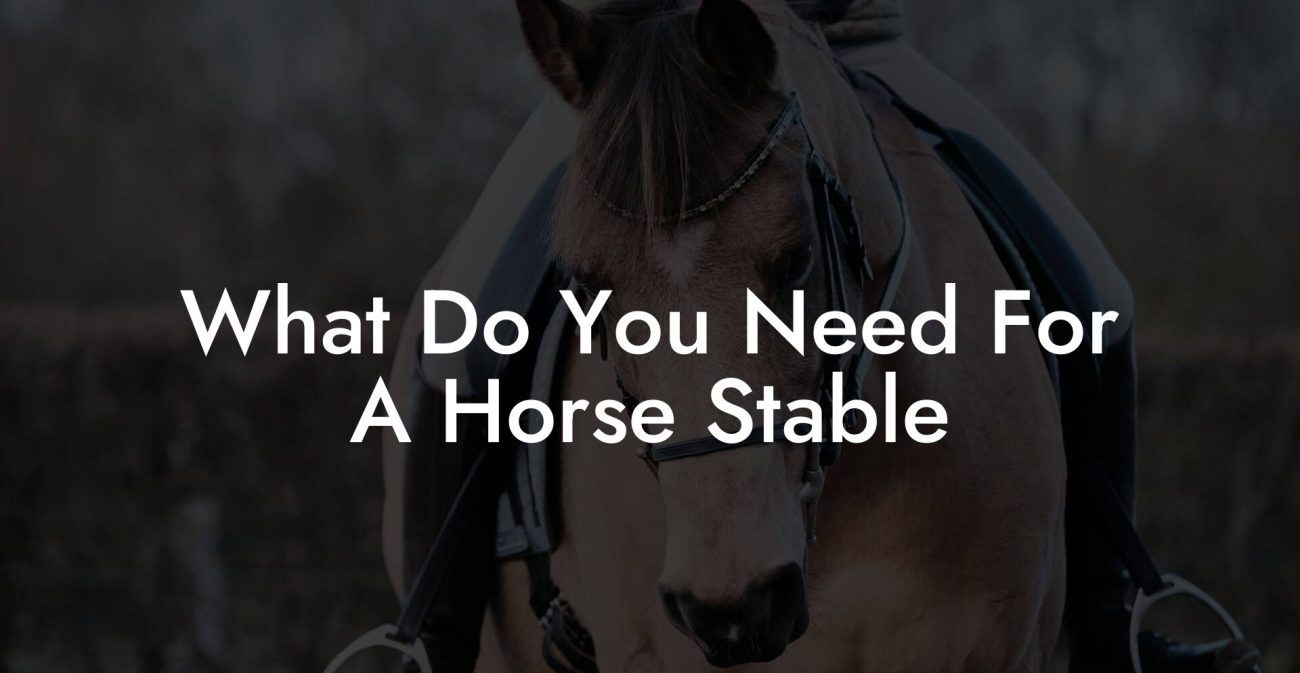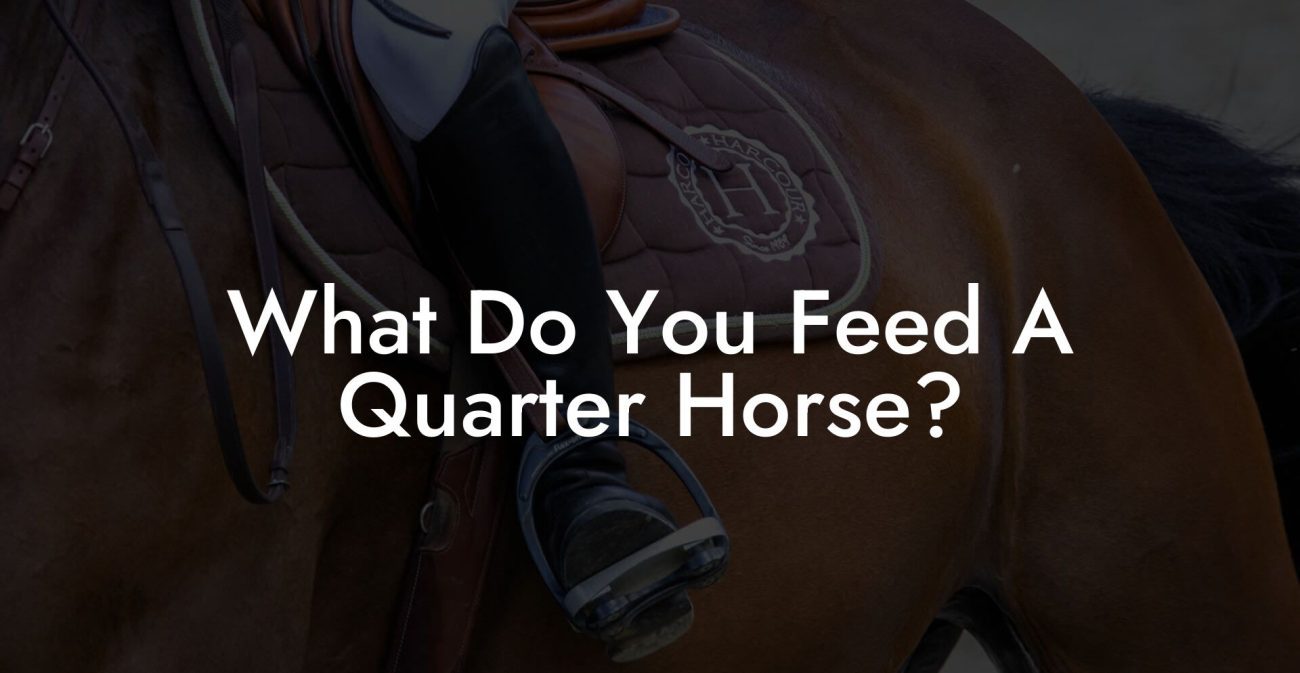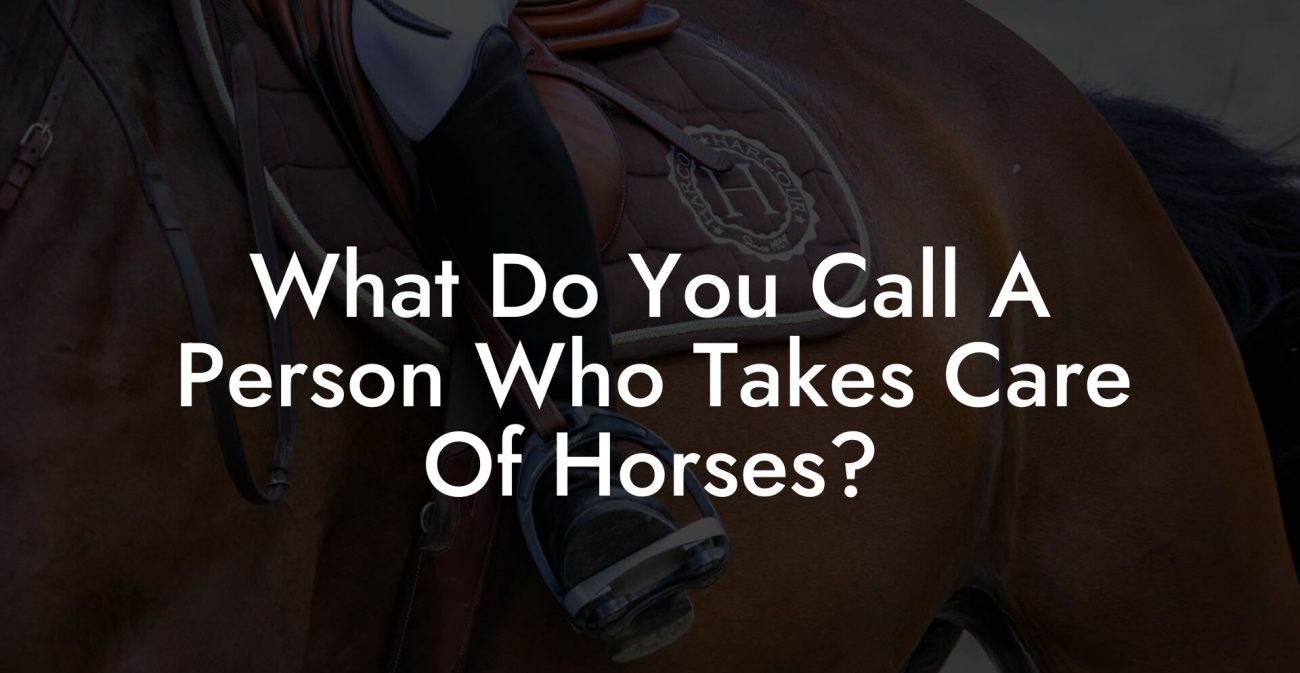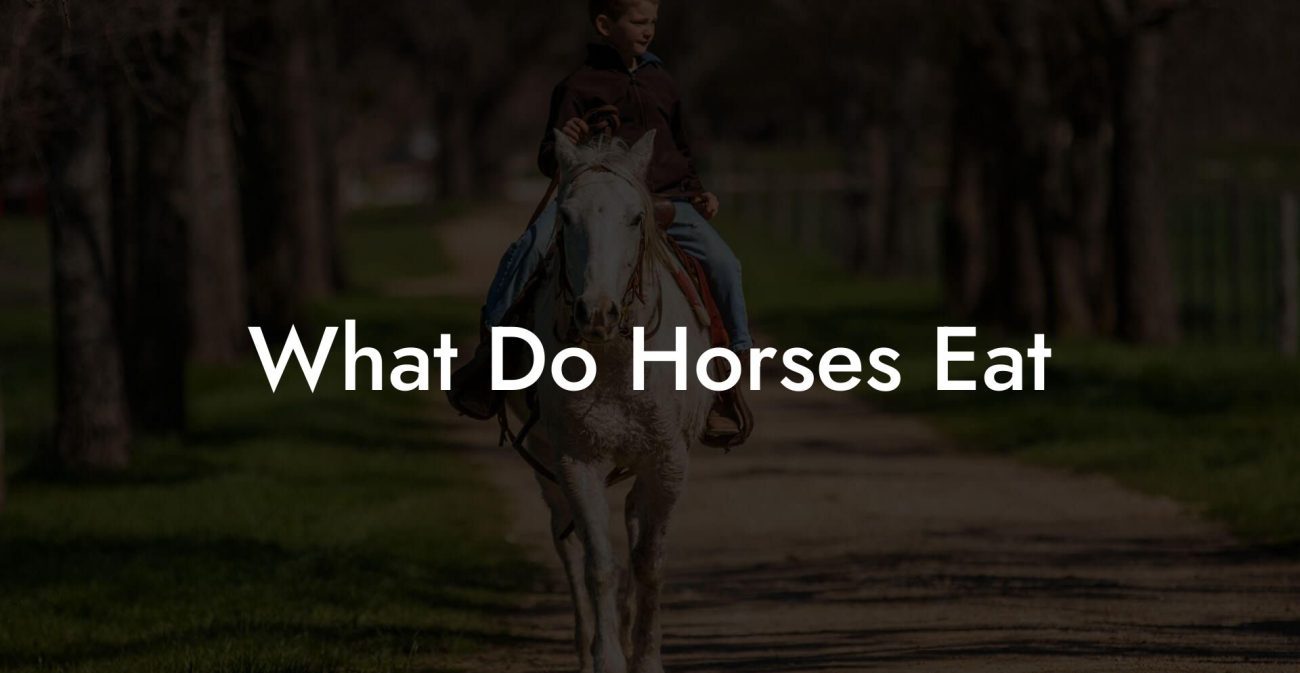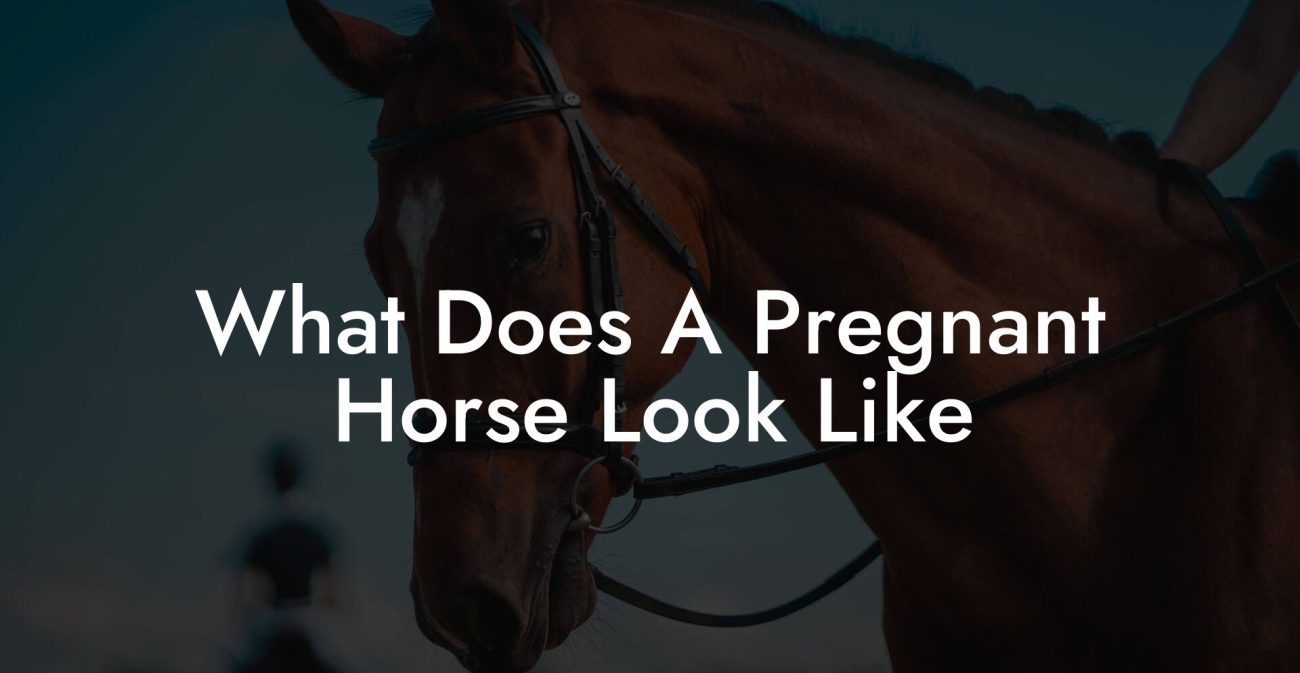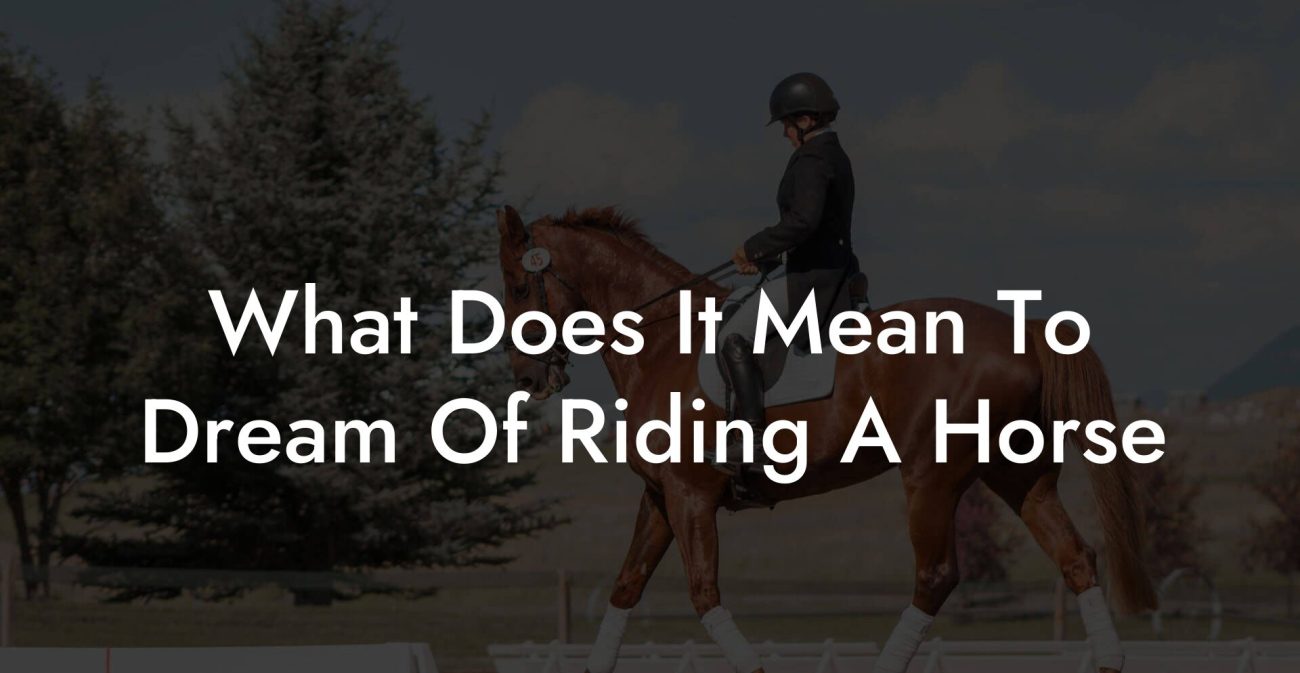Ever wondered how your favorite four-legged companion ends up with a condition as oddly named as “kissing spine”? This isn’t a romantic tale of equine affection, it’s a unique, sometimes painful, orthopedic issue where the vertebrae in a horse’s back come a little too close for comfort. For those who care about their horses, the Gen-Z trendsetters, the millennial equestrians, and everyone in between, understanding kissing spine is key to ensuring your equine buddy stays happy, healthy, and ready for adventure.
Quick Links to Useful Sections
- What Exactly Is Kissing Spine?
- The Anatomy Behind the “Kiss”
- How Does a Horse Get Kissing Spine?
- 1. Repetitive Impact and Stress
- 2. Saddle Fit and Riding Technique
- 3. Conformation and Build
- 4. Age and Wear
- 5. Trauma or Injury
- Recognizing the Signs: What to Look Out For
- Diagnosing Kissing Spine: The Veterinary Approach
- 1. Comprehensive Physical Examination
- 2. Radiographic Imaging (X-rays)
- 3. Ultrasound and Other Imaging Techniques
- 4. Gait Analysis
- Treatment Options: From Conservative Care to Advanced Interventions
- 1. Conservative Management
- 2. Complementary Treatments
- 3. Advanced Surgical Interventions
- Rehabilitation and Post-Treatment Care
- 1. Gradual Return to Work
- 2. Structured Physical Therapy Programs
- 3. Hydrotherapy
- 4. Monitoring and Adjustments
- Preventive Measures: Keeping Kissing Spine at Bay
- 1. Regular Veterinary Check-Ups
- 2. Proper Saddle Fitting
- 3. Balanced training Regimens
- 4. Maintaining a Healthy Weight
- 5. Groundwork and Flexibility Exercises
- Integrative and Holistic Approaches to Equine Back Care
- Nutritional Support for Spinal Health
- Acupuncture and Energy Healing
- Massage Therapy and Chiropractic Care
- Mindful Movement and Relaxation Techniques
- Managing Pain and Enhancing Performance
- Identifying Pain Triggers
- Pharmaceutical Interventions
- Tailored Exercise Regimens
- Environmental Modifications
- Equine Kissing Spine and Your Horse’s Overall Well-Being
- Resources and Community Support: Your Next Steps
- Creating Your Customized horse care Plan for Kissing Spine
- Step 1: Comprehensive Assessment
- Step 2: Set Clear, Achievable Goals
- Step 3: Integrate Multiple Modalities
- Step 4: Establish a Routine
- Step 5: Monitor, Evaluate, and Adjust
- FAQ: Your Equine Kissing Spine Questions Answered
- Your Path Forward to a Happier, Healthier Horse
What Exactly Is Kissing Spine?
Kissing spine, clinically known as overriding dorsal spinous processes, is an equine back condition where the bony projections (spinous processes) along the horse’s spine make contact with one another. Normally, a healthy spine maintains a comfortable gap between these processes to allow for smooth movement and flexibility. However, in horses with kissing spine, these spaces narrow, causing pain, inflammation, and sometimes a noticeable change in the horse’s behavior.
Despite its quirky name, kissing spine isn’t a cute story of horse affection, it’s a serious condition that can hinder a horse’s performance and well-being. Whether your horse is a top-level competition star or just your cherished companion on weekend trails, recognizing the signs of this condition can be a game changer.
The Anatomy Behind the “Kiss”
To truly grasp why a horse ends up with kissing spine, it helps to take a closer look at the animal’s anatomy. Picture the spine as a stack of individual blocks separated by flexible cushioning. In a healthy horse, these “blocks” (vertebrae) have enough space to move independently, absorbing the shocks of high-speed gallops or long days of plowing fields.
In the case of kissing spine, the dorsal spinous processes (the bony parts that stick out along the back) begin to overlap or “kiss” one another. This can lead to chronic irritation, localized pain, and a cascade of behavioral changes as the horse tries to cope with the discomfort. Medical research suggests that factors such as repetitive stress, poor saddle fit, and rapid changes in workload can contribute to this condition.
How Does a Horse Get Kissing Spine?
The development of kissing spine in horses isn’t linked to genetic destiny or some mystical equine curse, it’s the result of various mechanical and environmental factors coming together. Here’s what might lead to those spinous processes getting a little too cozy:
1. Repetitive Impact and Stress
Horses subjected to repetitive high-impact activities, think racing, show jumping, or even rigorous trail riding, are more prone to developing kissing spine. The constant jarring and pounding on uneven terrain can cause microtrauma to the spinal column, eventually leading to inflammation and close contact between the vertebrae.
2. Saddle Fit and Riding Technique
A poorly fitted saddle is more than just a comfort issue. When a saddle doesn’t distribute weight evenly, it can place extra pressure on a horse’s back. Over time, this concentrated pressure may cause the vertebrae to be forced together. Equine experts advise that regular saddle fitting checks are crucial to prevent undue stress on the horse’s spine.
3. Conformation and Build
Just as no two humans are alike, horses come with their own unique conformations. Some horses may be naturally predisposed to conditions like kissing spine due to structural anomalies or specific build characteristics. A horse with a naturally short back or a pronounced arch might be more susceptible to vertebral compression.
4. Age and Wear
Age is just a number until it comes to joint and bone health. As horses grow older, the cumulative stress on their spines can lead to degenerative changes. This wear and tear over the years can cause the protective cartilage and intervertebral discs to thin out, increasing the likelihood of the spinous processes touching.
5. Trauma or Injury
Accidents happen, even to horses. A hard fall or a direct blow to the back can precipitate changes in the spine alignment, eventually resulting in kissing spine. Post-traumatic inflammation and scar tissue may contribute to the condition’s progression.
Recognizing the Signs: What to Look Out For
As a dedicated horse owner, you’re the first line of defense when it comes to spotting equine ailments. But what does kissing spine look like in real life? Fortunately, there are several signs that can tip you off:
- Behavioral Changes: Watch for reluctance to move, changes in demeanor, or signs of discomfort during rides. A usually energetic horse might start showing signs of irritability or stiffness.
- Reduced Performance: Your horse may underperform during activities it once loved. Whether it’s a drop in speed, reluctance to jump, or simply looking tired, these can be indicators of underlying back pain.
- Physical Pain: During a physical examination, you might notice tenderness along the back. The horse might also display avoidance behaviors when you palpate its back.
- Visible Spinal Issues: In some cases, advanced kissing spine can result in observable changes in the back’s contour, though this is often subtle.
Early detection can prevent further complications, so if your horse is acting off its usual self, a veterinary check-up is always a smart move.
Diagnosing Kissing Spine: The Veterinary Approach
Diagnosing kissing spine involves more than just a visual examination. Veterinarians rely on a series of diagnostic tools and techniques to uncover the truth behind your horse’s discomfort. Here’s a peek into the process:
1. Comprehensive Physical Examination
Your vet will begin with a detailed physical exam, checking for areas of tenderness, stiffness, and pain response along the spine. They’ll ask questions about your horse’s exercise routine, behavior, and any recent changes in performance.
2. Radiographic Imaging (X-rays)
X-rays are the gold standard for visualizing the bony structures of the spine. These images can reveal abnormalities in the alignment and spacing of the vertebrae, helping to confirm a diagnosis of kissing spine.
3. Ultrasound and Other Imaging Techniques
In some cases, ultrasound can be used to assess soft tissue and rule out other conditions that might mimic the symptoms of kissing spine. Advanced imaging technologies like MRI or CT scans are less common in equine practice but can offer a more detailed look when necessary.
4. Gait Analysis
Observing your horse’s movement can provide clues about the source of the discomfort. Abnormal gait patterns, such as stiffness or uneven strides, might suggest underlying spinal issues.
While the diagnosis might sound technical, the goal is simple: to understand the extent of the condition so that a tailored treatment plan can be developed.
Treatment Options: From Conservative Care to Advanced Interventions
Just because kissing spine is a serious condition doesn’t mean you and your horse are without options. A range of treatments, from conservative management to advanced surgical interventions, can help alleviate pain and improve performance.
1. Conservative Management
For many horses, the first step is a conservative approach focused on improving comfort and function:
- Rest and Reduced Workload: Reducing high-impact activities gives your horse time to heal and prevents further stress on the spine.
- Anti-inflammatory Medications: Non-steroidal anti-inflammatory drugs (NSAIDs) can help reduce pain and inflammation. Your vet will determine the appropriate dosage and duration.
- Physical Therapy: Targeted exercises, stretching, and massage therapy can alleviate muscle spasms and improve flexibility. Working with an equine physiotherapist can be especially beneficial.
- Saddle Fitting and Corrective equipment: A well-fitted saddle distributes weight evenly, reducing undue pressure on the back. In some cases, special pads or corrective gear may be recommended.
2. Complementary Treatments
Complementary therapies add a holistic twist to traditional management:
- Acupuncture: This ancient practice is increasingly popular among horse enthusiasts. By stimulating specific points along the spine, acupuncture may reduce pain and promote circulation.
- Chiropractic Adjustments: Some practitioners use equine chiropractic care to realign the spine, potentially decreasing the pressure between the vertebrae.
- Shockwave Therapy: Also known as extracorporeal shockwave therapy (ESWT), this non-invasive treatment uses sound waves to stimulate healing in the affected areas.
3. Advanced Surgical Interventions
When conservative and complementary measures fall short, surgery may become a viable option. Procedures aimed at alleviating kissing spine include:
- Surgical Resection: Removing a small section of a problematic spinous process can create the space needed for smooth movement.
- Interspinous Implant Placement: Inserting a specialized implant between the spinous processes may serve as a cushion, preventing direct contact and reducing discomfort.
Advanced interventions require careful evaluation by a veterinary surgeon experienced in equine orthopedics. While surgery is not always the first line of defense, it can offer significant relief and improved quality of life for horses with severe forms of kissing spine.
Rehabilitation and Post-Treatment Care
Once treatment is underway, what comes next is equally important: a thoughtful rehabilitation plan to ensure your horse recovers fully, yet steadily. We’re talking about a tailored program that emphasizes gradual progress over dramatic, risky leaps.
1. Gradual Return to Work
After a period of rest and treatment, it’s essential to reintroduce exercise slowly. A regimented plan that ramps up activity levels gradually helps avoid re-injury. Depending on the severity of the kissing spine, your vet and equine therapist will design a schedule that balances exercise with ample recovery time.
2. Structured Physical Therapy Programs
Just as humans benefit from regular physical therapy after an injury, your horse will gain from targeted exercises and stretches. These activities can include core strengthening routines, stretching for flexibility, and specific back therapies designed to ease the pressure on the spine.
3. Hydrotherapy
Water-based therapies are increasingly popular among horse owners. Warm water can reduce joint tension and support gentle exercise in a low-impact environment. Swimming or underwater treadmill work are excellent examples of hydrotherapy that aid recovery without the harsh impact on the back.
4. Monitoring and Adjustments
Regular check-ups and follow-up imaging tests help track the progress of the condition. Adjustments to the treatment plan are made based on how well your horse is responding to therapy. The idea is to create a feedback loop that ensures continuous improvement in the horse’s quality of life.
Rehabilitation is more than an afterthought, it’s a critical phase that promises long-term relief. By committing to a comprehensive post-treatment plan, you’re giving your horse the best chance for a smooth, sustained recovery.
Preventive Measures: Keeping Kissing Spine at Bay
Preventing kissing spine in the first place is always preferable to managing it later on. With some proactive steps, you can reduce the risk of your horse developing this condition:
1. Regular Veterinary Check-Ups
Routine exams aren’t just for humans, your horse needs them too! Regular visits by your trusted veterinarian can catch early signs of back problems before they evolve into more serious issues.
2. Proper Saddle Fitting
A custom-fit saddle isn’t just a luxury; it’s a necessity. Ensuring that your saddle is adjusted for your horse’s unique back shape can distribute weight evenly and prevent unnecessary spinal pressure.
3. Balanced training Regimens
Avoid overloading your horse with high-impact activities day after day. A well-rounded training program that alternates between high-intensity workouts and restful, low-impact exercises can help maintain overall spinal health.
4. Maintaining a Healthy Weight
Extra weight means extra pressure on the back. Keeping your horse at an optimal body condition through good nutrition and balanced exercise reduces the stress on its spine.
5. Groundwork and Flexibility Exercises
Beyond riding, engaging your horse in regular groundwork exercises can improve overall back flexibility. Activities like stretching routines or even structured play can help keep the spine limber.
By staying on top of your horse’s overall health and wellness, you’re not just preventing kissing spine, you’re setting your equine friend up for a long, thriving life.
Integrative and Holistic Approaches to Equine Back Care
Just like humans, horses can also benefit from integrative and holistic care. Combining conventional therapies with complementary treatments isn’t just a trend, it’s a smart way to tackle multifaceted issues like kissing spine holistically.
Nutritional Support for Spinal Health
Nutrition plays a critical role in supporting musculoskeletal health. A balanced diet that includes anti-inflammatory foods, optimal levels of vitamins and minerals, and quality protein helps repair and maintain tissue integrity. Consider incorporating supplements recommended by your vet, glucosamine and chondroitin, for instance, are known to support joint health.
Acupuncture and Energy Healing
Acupuncture isn’t just for humans. Many horse owners report positive outcomes when their equine companions receive acupuncture sessions. This ancient practice stimulates nerve pathways, reduces inflammation, and promotes overall energy balance, helping to alleviate some of the pain associated with kissing spine.
Massage Therapy and Chiropractic Care
Regular massage therapy and occasional chiropractic adjustments can work wonders. These therapies help release muscle tension and improve blood flow to the back, enhancing the healing process. An experienced equine massage therapist or chiropractor can help ensure that your horse’s spine is receiving the supportive care needed to offset the challenges of kissing spine.
Mindful Movement and Relaxation Techniques
Believe it or not, even horses benefit from something akin to mindfulness. Some trainers incorporate elements of relaxation and gentle stretching into the daily routine, allowing the horse to move with less anxiety and more fluidity. This approach not only benefits the back but also promotes overall mental wellness in your equine companion.
By merging conventional treatment methods with these integrative techniques, you create a holistic care plan that addresses the physical, nutritional, and even emotional needs of your horse.
Managing Pain and Enhancing Performance
Pain management in horses is a delicate balance between alleviating discomfort and maintaining performance. When dealing with kissing spine, pain can be both a hindrance and a signal. Here, we break down practical strategies to keep your horse moving comfortably:
Identifying Pain Triggers
Understanding what triggers your horse’s pain is a crucial step. Whether it’s an improperly fitted saddle, overexertion, or even a specific type of terrain, recognizing these factors allows you to modify your horse’s environment accordingly.
Pharmaceutical Interventions
While long-term reliance on pain medications isn’t ideal, short-term usage under veterinary supervision can help manage acute pain episodes. Anti-inflammatory drugs, muscle relaxants, and other prescribed medications are tools to bridge the gap during recovery periods.
Tailored Exercise Regimens
Not all exercise is created equal when your horse is dealing with kissing spine. Practicing low-impact exercises, gradually increasing intensity, and incorporating warm-up and cool-down routines help safeguard against further injury while maintaining overall fitness.
Environmental Modifications
Sometimes, a simple change in the environment can make all the difference. Soft footing, well-maintained arenas, and even reducing the time on hard surfaces can reduce the stress on your horse’s back.
These practical approaches to pain management work hand in hand with medical treatments and rehabilitative care, ensuring that your horse experiences less discomfort and can continue performing at its best.
Equine Kissing Spine and Your Horse’s Overall Well-Being
Beyond the technicalities of diagnosis and treatment, it’s important to view kissing spine in the broader context of your horse’s overall well-being. After all, a happy, healthy horse is one that thrives both physically and emotionally.
Caring for a horse with kissing spine involves:
- Regular Monitoring: Keeping an eye on any changes in gait, behavior, or comfort level helps catch issues early.
- Balanced Workloads: Adjusting your horse’s schedule to include rest and recovery means fewer flare-ups and a more balanced life.
- Mental Stimulation and Enrichment: Don’t forget, mental health matters too! Enrich your horse’s daily routine with social interactions, varied scenery, and even simple puzzles.
When you consider the horse as a whole being, every preventive measure, every tweak in routine, and every integrative treatment plays a role in creating a supportive environment that fosters overall wellness.
Resources and Community Support: Your Next Steps
Managing a condition like kissing spine isn’t a journey to be taken alone. Fortunately, there is a wealth of resources and a robust community of equine enthusiasts ready to share advice, support, and cutting-edge insights.
Here’s how you can tap into the community and further your learning:
- Veterinary Specialists: Reach out to equine orthopedic specialists and veterinarians who are well-versed in kissing spine. Their expertise can provide tailored advice specific to your horse’s needs.
- Local Equine Clubs and Forums: Join online forums, social media groups, or local equine clubs where fellow horse owners discuss their experiences with back conditions. These platforms are a goldmine of practical tips and personal stories.
- Workshops and Webinars: Many equine organizations host events focused on back care, saddle fitting, and integrative therapies. Participating in these events can help you stay informed about the latest trends and treatments.
- Educational Materials: Invest in books, videos, and courses that dive deep into equine biomechanics and back care. Knowledge is power, and staying educated is a proactive way to safeguard your horse’s future.
- Support Groups: Whether online or in person, supportive groups can help you navigate the emotional ups and downs of managing a chronic condition in your horse.
With these resources at your fingertips, you’re empowered to make informed decisions and implement best practices in your horse’s daily care routine. Your proactive approach will not only improve your horse’s quality of life, it will make your shared journey that much more rewarding.
Creating Your Customized horse care Plan for Kissing Spine
No two horses are the same, and your approach to managing kissing spine should reflect that. Creating a personalized equine care plan involves understanding your horse’s unique needs, the severity of the condition, and your day-to-day circumstances.
Step 1: Comprehensive Assessment
Begin with a thorough examination by a qualified equine veterinarian. This assessment should include a physical evaluation, diagnostic imaging, and a review of your horse’s work history. The goal is to understand the full scope of the problem.
Step 2: Set Clear, Achievable Goals
Whether your objective is to restore performance, reduce pain, or simply improve everyday comfort, setting clear goals will guide your treatment plan. Goals should be realistic, measurable, and flexible enough to adapt as needed.
Step 3: Integrate Multiple Modalities
A holistic equine care plan might include:
- Veterinary-guided rehabilitation exercises
- Targeted physical therapy and massage
- Complementary treatments like acupuncture and chiropractic care
- Customized saddle fitting and hardware adjustments
- Nutritional support and possibly supplements for joint health
Step 4: Establish a Routine
Consistency is key. Develop a daily or weekly schedule that includes time for exercise, therapy sessions, resting periods, and nutritional monitoring. Using technology like mobile apps to track progress can help keep everyone in sync.
Step 5: Monitor, Evaluate, and Adjust
Regular re-evaluations are essential. Keep a detailed log of your horse’s progress, any changes in behavior, performance, or pain levels should be noted. Collaborate with your vet to fine-tune the plan as your horse improves or if setbacks occur.
Your customized care plan is a living document that evolves as your horse’s needs change. With a balanced mix of traditional veterinary care and holistic strategies, you’ll manage kissing spine in a way that’s uniquely suited to your horse.
FAQ: Your Equine Kissing Spine Questions Answered
We know you have questions about kissing spine, so here are some of the most frequently asked queries by horse owners like you:
1. What exactly causes kissing spine in horses?
Kissing spine is typically due to a combination of repetitive strain, poor saddle fit, age-related wear, and sometimes trauma. It results in the dorsal spinous processes coming into contact, leading to pain and discomfort.
2. How can I tell if my horse is suffering from kissing spine?
Look out for behavioral signs like reluctance to move, changes in performance, and signs of physical pain along the back. A veterinary diagnosis, often supported by imaging tests like X-rays, is necessary for confirmation.
3. Is kissing spine a hereditary condition?
While certain conformation traits may predispose a horse to developing kissing spine, it is generally not considered strictly hereditary. Lifestyle factors and management practices often play a significant role.
4. What are the most effective treatments for kissing spine?
Treatment varies depending on severity. Conservative measures include rest, anti-inflammatory medications, and physical therapy; complementary treatments such as acupuncture and chiropractic care may also be beneficial. In severe cases, surgical options are available.
5. Can proper saddle fitting really make a difference?
Absolutely. A properly fitted saddle distributes weight evenly and minimizes undue pressure on the back, reducing the risk and severity of kissing spine.
6. How long does recovery typically take?
Recovery varies from horse to horse. With a comprehensive rehabilitation plan, many horses show improvements within a few months, but full recovery might take longer, especially with more severe cases.
7. Are there any dietary recommendations for horses with kissing spine?
Yes, a balanced diet rich in anti-inflammatory foods, lean proteins, and essential nutrients supports tissue repair and overall spinal health. Discuss supplements and dietary adjustments with your vet.
8. Can kissing spine be prevented altogether?
Prevention is possible with regular veterinary check-ups, proper saddle fitting, balanced training, and maintaining your horse’s overall health and weight.
9. Is there a risk of kissing spine affecting my horse’s performance permanently?
With early detection and an effective treatment plan, many horses continue to perform well. However, neglected cases may result in chronic pain and performance limitations.
10. How can I stay updated on the latest treatment methods for kissing spine?
Engage with equine specialist communities online, attend workshops or webinars, and maintain regular communication with your veterinarian. Staying informed is key to your horse’s ongoing care.
Your Path Forward to a Happier, Healthier Horse
Although kissing spine may sound like a quirky, almost humorous phrase, the impact it has on your horse is all too real. Addressing this condition head-on with a combination of informed veterinary care, integrative therapies, and proactive management is the best route toward a pain-free, joyful life for your equine friend.
Every horse is unique, your approach to managing kissing spine should be, too. Embrace the blend of scientific innovation and holistic care to customize a plan that not only alleviates discomfort but also enhances overall performance and quality of life.
Whether you’re a seasoned horse owner or a newcomer to the equestrian world, understanding and managing conditions like kissing spine is part of a broader journey of care and compassion. By staying informed, connected, and proactive, you’re ensuring that your horse can continue to be your trusted partner in countless adventures.
Now’s the time to take that next step. Reevaluate your horse’s care routine, engage with knowledgeable experts, and join a community that’s all about making the best decisions for our four-legged friends. Your dedication will pave the way to many more years of shared trails, wins at the arena, and quiet moments of companionship.
With the right balance of science, compassion, and a little bit of humor, you’ll transform challenges into successes, ensuring that your horse’s back stays as strong and resilient as the spirit that comes with every ride.

